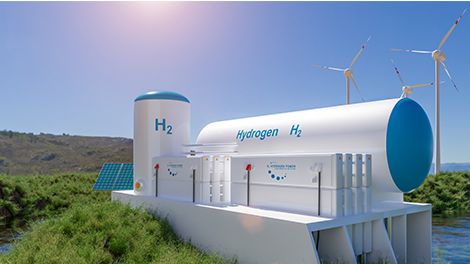Using hydrogen: What does a fuel cell do?
A fuel cell is needed to convert hydrogen (H2) into electricity; strictly speaking, this is a hydrogen-oxygen fuel cell. It is also often referred to simply as a "hydrogen fuel cell". In the following, "fuel cell" and "hydrogen fuel cell" are used synonymously. In hydrogen fuel cells, hydrogen serves as the fuel and oxygen (O2) as the oxidant. By converting chemical energy directly into electrical energy and heat, hydrogen fuel cells have significantly higher efficiencies than conventional power plants.
In combination with a fuel storage system and hydrogen recycling, fuel cell systems enable pollution-free energy generation. The power spectrum of hydrogen fuel cells ranges from the sub-kW range of individual cells to the MW range in the form of virtual power plants. The field of application of hydrogen fuel cells ranges from heat and power supply in buildings to off-grid applications and the propulsion of vehicles, aeroplanes and ships. Fuel cells have increasingly come into focus, especially due to the discussions about the role of hydrogen in e-mobility.
Fuel cell: function and design
How does a fuel cell work and how is it designed? A fuel cell consists of a network of several cells that are separated by separators and arranged in a stack. The structure of a fuel cell is planar in layers or, in the case of solid oxide fuel cells, tubular as a tube system. Electrolysis plays a decisive role in the functioning of fuel cells: the core of an individual fuel cell is formed by a liquid or solid electrolyte, which is enclosed on both sides by bipolar electrode plates (anode and cathode).
These plates have a porous diffusion layer (GDL - gas diffusion layer), which guides the reaction gases over a precious metal-coated catalyst surface (low and medium temperature range) or over a catalyst made of nickel, ceramic or steel (high temperature range). This is how, in most fuel cell types, the hydrogen is split on the anode side and the electrons are discharged to the electrical consumer. The hydrogen protons migrate through the electrolyte to the cathode side, where they combine with the added oxygen to form water (H2O).
Fuel cell efficiency
Fuel cells use hydrogen to generate electricity. The hydrogen drive in a fuel cell vehicle is a well-known example: the electricity from the fuel cell drives corresponding vehicles, with only emission-free water vapour ultimately being emitted from the exhaust. Currently, the efficiency of a fuel cell is about 60 %. This technology should not be confused with that of a hydrogen engine, which is a hydrogen combustion engine.
For comparison: electrolysis has an efficiency of 60 to 70 %. A modern petrol engine or gasoline engine has an efficiency of about 24 %, whereas diesel engines are able to use about 40 % of the energy stored in the fuel. Aircraft engines also achieve similar efficiencies to vehicle engines, depending on the quality of the engine. Thus, there is much to be said for the use of fuel cells in vehicles that have to travel longer distances and move heavier loads every day.
Hydrogen is a topic with many facets - from production, transport and storage to use. With our expertise, know-how and many years of experience, we are an independent partner for safety and security by being able to test, inspect and certify various aspects of hydrogen technology.
Types of fuel cells
Six different types of hydrogen fuel cells are currently in use. These fuel cell types convert different gases into electricity, use different electrolytes and are classified as low, medium or high temperature fuel cells depending on their operating temperature. The individual fuel cell types are specifically assigned to the following categories:
- Low temperature fuel cells: Alkaline fuel cell, membrane fuel cell, direct methanol fuel cell
- Medium and high temperature fuel cells: Phosphoric acid fuel cell, molten carbonate fuel cell, solid oxide fuel cell.
The range of applications for hydrogen fuel cells is large and growing constantly, as they are reliable in operation, low-maintenance and environmentally friendly. While all types of fuel cells are suitable for stationary applications, mainly low-temperature fuel cells are used in portable and mobile applications.
|



